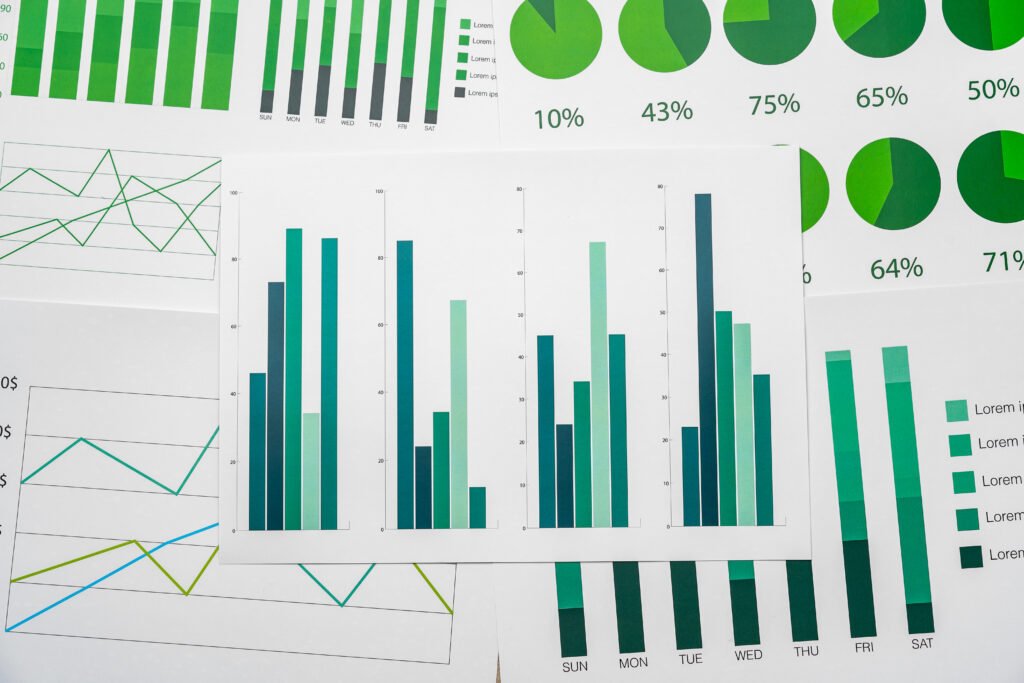Ever wondered what your Compound Annual Growth Rate (CAGR) on investments is?
Or how much your expenses have increased on average over the past five years?
Curious about the annual compounded growth in company revenues?
Or the average annual growth in your subscriber base over the last few years?
These questions might sound familiar, especially if you’ve ever talked to investment advisors, bankers, or finance experts. They often throw around terms like CAGR, AAGR, and absolute growth like it’s everyday lingo, and all you could do was smile and nod while your brain quietly panicked.
You’re not alone.
Whether it’s your investment returns, company revenues, or even how much your monthly grocery bill has grown, understanding “growth” sounds easy until you dive into the numbers. So, let’s break it all down like two friends chatting over a cup of coffee. No jargon overload, no math panic. Just simple, relatable explanations.
(Psst. :You can download the companion excel file here and follow along).
What is Growth Rate?
Let’s say you invested ₹10,000 in a mutual fund. Five years later, it’s grown to ₹18,000. That’s an ₹8,000 gain or 80% total return. Sounds great, right?
Well… sort of.
That’s called absolute growth, a one-shot measure. But what if you wanted to know how much it grew every year on average? That’s where we enter the world of Average annual growth rate (AAGR) and Compound annual growth rate (CAGR).
Let’s demystify these two cousins of financial metrics.
Meet AAGR : The Straightforward One (But a Bit Naive)
Imagine your investment of ₹ 10,000 in a mutual fund grows over a period of 5 years as follows:-
| Year | Value of Investment |
| 0 | 10,000 |
| 1 | 12,500 |
| 2 | 13,500 |
| 3 | 15,000 |
| 4 | 16,000 |
| 5 | 18,000 |
Now, you might think: “Hey, 80% over 5 years. That’s 16% per year, right?”
Not quite. That’s just dividing 80% by 5. AAGR takes a slightly different approach. It looks at how much your money grew each year and then averages those annual growth rates. Here’s what it looks like:
| Year | Value of Investment | Annual Growth % |
| 0 | 10,000 | |
| 1 | 12,500 | (12500 – 10000)/10000 = 25% |
| 2 | 13,500 | (13500 – 12500)/12500 = 8% |
| 3 | 15,000 | (15000 – 13500)/13500 = 11% |
| 4 | 16,000 | (16000 – 15000)/15000 = 7% |
| 5 | 18,000 | (18000 – 16000)/16000 = 13% |
| Average Annual Growth Rate = | (25% + 8% + 11% + 7% + 13%)/5 = 12.7% | |
Average annual growth rate (AAGR) is the arithmetic mean of a series of growth rates.
In our above example, first we will compute the yearly growth rates using the formula:
Yearly Growth rate = (Ending Value – Beginning Value) / Beginning Value
Average those out and you get 12.7% AAGR. Sounds reasonable, right?
But here’s the twist…
What if in year 6, the markets crash and your fund drops back to ₹10,000?
Now your average looks like this:
| Year | Value of Investment | Annual Growth % |
| 0 | 10,000 | |
| 1 | 12,500 | (12500 – 10000)/10000 = 25% |
| 2 | 13,500 | (13500 – 12500)/12500 = 8% |
| 3 | 15,000 | (15000 – 13500)/13500 = 11% |
| 4 | 16,000 | (16000 – 15000)/15000 = 7% |
| 5 | 18,000 | (18000 – 16000)/16000 = 13% |
| 6 | 10,000 | (10000 – 18000)/18000 = -44% |
| Average Annual Growth Rate = | (25% + 8% + 11% + 7% + 13% – 44%)/6 = 3.1% | |
Suddenly, AAGR drops to 3.1%, even though your actual return is 0% (you ended where you started!).
This is where AAGR can be misleading. It doesn’t understand the magic (and pain) of compounding and market volatility.
AAGR is useful for determining trends or growth rates and it can be applied to almost any financial measure, including revenue, profit, expenses, cash flow, subscriber or customer base etc. to give investors an idea of which direction a company is headed for that particular measure. However, used out of context, AAGR can be very misleading.
Enter CAGR: The More Realistic One
Think of CAGR as the “if my money grew at a steady rate every year” number. It’s the rate at which your investment would need to grow consistently each year to get from the starting point to the ending point.
The formula for CAGR is:
CAGR = ( Ending Value / Beginning Value) 1/n – 1
where n = Number of periods (months, years, etc.)
Let’s go back to our original 5-year example:
- From ₹10,000 to ₹18,000 in 5 years
CAGR = (18,000 / 10,000) 1/5 – 1 = 0.1247 or 12.5%
You may say, what a big deal? Much closer to AAGR, right? But now, throw in that year 6 market crash (₹10,000 again), and CAGR becomes…
CAGR = (10,000 / 10,000) 1/6 – 1 = 0 or 0%
Spot on. Because your money didn’t really grow overall. That’s the beauty of CAGR, it keeps things grounded in reality, even if life (or markets) are messy (volatile).
But What About Volatility?
CAGR’s cool, but it doesn’t show you how bumpy the ride was. Two investments may have the same CAGR, but one might’ve been a peaceful stroll while the other was a rollercoaster.
Let’s say your mutual fund had this ride:
| Year | Value of Investment | Annual Growth % |
| 0 | 10,000 | |
| 1 | 15,000 | 50% |
| 2 | 12,000 | -20% |
| 3 | 17,000 | 42% |
| 4 | 15,000 | -12% |
| 5 | 21,000 | 40% |
| Average Annual Growth Rate = | 20% | |
AAGR = 20%
CAGR = (21,000 / 10,000) 1/5 – 1 = 16%
That’s a pretty big gap. The real return on investment is the CAGR, and not the Absolute or Average Annual Growth Return as many investment brokers and fund managers may claim.
However, CAGR is also not free from its pitfalls. While CAGR is superior to average returns because it considers the assumption that an investment is compounded over time, yet CAGR is only a smoothed return over the time/period measured, only taking into account an initial and a final value.
Risk Adjusted CAGR
The real-world takeaway? Volatility hurts your actual returns. And that’s why some investors look at risk-adjusted CAGR, which basically says: “Yeah, I earned 16%, but how much stress did I take to get there?”
Very volatile investments have large standard deviations because their annual returns can vary significantly from their average annual return. Less volatile stocks have smaller standard deviations because their annual returns are closer to their average annual return. For example, the standard deviation of a savings account is zero because the annual rate is the expected rate of return (assuming you don’t deposit or withdraw any money). In contrast, a stock price can vary significantly from its average return, thus causing a higher standard deviation. The standard deviation of a stock is generally greater than the savings account or a bond held to maturity.
A simplified formula?
Risk-adjusted CAGR = CAGR × (1 – Standard Deviation)
The more volatile the investment, the larger its standard deviation and lower the risk-adjusted CAGR.
Quick Tip: How to Calculate CAGR in Excel
Don’t want to deal with formulas in your head? Excel’s got your back.
You may calculate CAGR in Excel by using the above basic formula in a cell.
After entering the formula, if you see the result in a decimal, you may change the cell format to percentage.
You can also use Excel’s built in function RRI or RATE function as follows:
= RRI (nper, pv, fv)
Where nper = Number of periods (months, years, etc.)
pv = Amount of initial investment
fv = Amount of investment at maturity
i.e. RRI(5, 10000, 21000)
or
= RATE (nper, pmt, pv, fv)
Where nper = Number of periods (months, years, etc.)
pmt = Additional payments
(Since there are no additional investments in our example, simply enter 0)
pv = Amount of initial investment (Enter this amount with minus sign)
fv = Amount of investment at maturity
i.e. RATE(5,0, -10000, 21000)
Download the companion excel file here and see the formulae in action. Just change the values based on your investment details. Easy peasy.
Final Thoughts: So, What Should You Use?
When someone talks about investment returns or business growth:
- Absolute Growth gives you the big picture (but lacks time perspective).
- AAGR is simple but can lie when things get bumpy.
- CAGR? That’s your most reliable friend. It tells you the real story.
- Risk-Adjusted CAGR? That’s the wise one who’s seen some stuff.
So next time someone pitches you a fund or investment promising “average 18% returns,” you’ll know to ask: “Is that CAGR or just an average?” (You’ll sound like a pro!)

